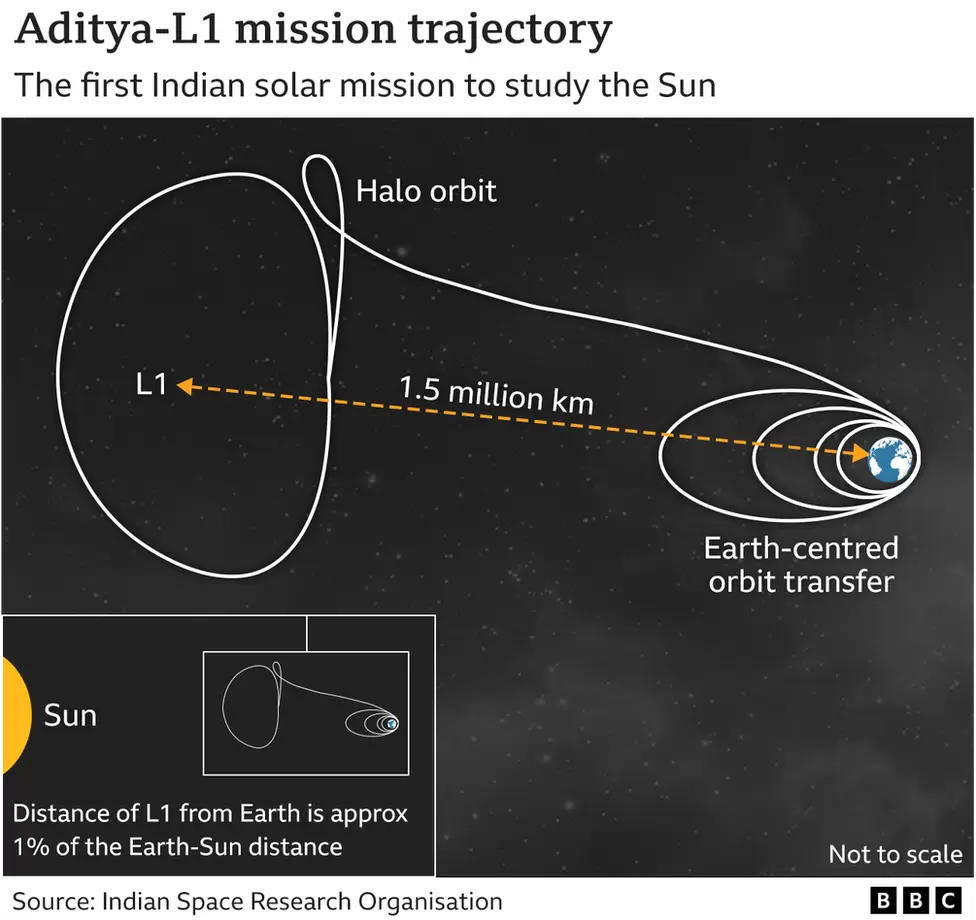India has achieved yet another milestone in space exploration following its recent historic lunar landing. The country’s inaugural sun observation mission, Aditya-L1, successfully launched from Sriharikota at 11:50 AM India time on a meaningful Saturday, marking a significant step forward in space exploration.
A Journey to the Heart of the Solar System
Aditya-L1 is set to embark on a remarkable journey, traveling 1.5 million kilometers (932,000 miles) from Earth, equivalent to just 1% of the Earth-Sun distance. The mission is expected to take approximately four months to reach its destination.
Honoring the Sun God, Surya
The mission derives its name, Aditya-L1, from the Hindu god of the Sun, Surya, paying homage to the celestial body it aims to study. Additionally, “L1” represents Lagrange point 1, a strategic location between the Sun and Earth, where the spacecraft is destined.
The Fascinating Concept of Lagrange Points
Lagrange points are unique spots in space where the gravitational forces of two large objects, such as the Sun and Earth, balance perfectly. This equilibrium allows spacecraft to essentially “hover” in place. Aditya-L1, upon reaching this Lagrange point, will orbit the Sun at the same rate as Earth, requiring minimal fuel to maintain its position.
A Spectacular Launch and Mission Overview
On the launch day, thousands of enthusiastic spectators gathered at the viewing gallery established by the Indian Space Research Agency (ISRO) near the launch site. The event was also broadcast live on national television, with commentators describing it as a “magnificent” success. ISRO scientists confirmed the launch’s success, asserting that the spacecraft’s performance is within the expected parameters.
Aditya-L1’s Unique Observational Capabilities
Aditya-L1’s strategic positioning will enable continuous observation of the Sun, even during solar eclipses, facilitating crucial scientific research. The mission is equipped with seven scientific instruments designed to study the solar corona, the photosphere (the Sun’s visible surface), and the chromosphere, providing real-time insights into solar activity and its impact on Earth and near-space weather.
Bridging the Gaps in Space Weather Knowledge
Former ISRO scientist Mylswamy Annadurai highlights the profound influence of the Sun on Earth’s weather and space weather. Understanding solar activity, such as solar wind and solar flares, is crucial as it can affect satellites and power grids on Earth. Aditya-L1 aims to fill knowledge gaps in space weather, enhancing satellite longevity and the effectiveness of space-based technologies.
The Role of Aditya-L1 in India’s Space Endeavors
With over 50 operational satellites in space, India relies on these assets for critical services such as communication, weather data, and disaster prediction. Aditya-L1 promises to provide advanced insights and early warnings related to solar activity, safeguarding India’s space assets and infrastructure.
Also Read: Russia-Led Alliance Holds Belarus Military Exercises Near NATO Border
The Quest to Understand Our Sun
Mylswamy Annadurai emphasizes that Aditya-L1’s mission extends beyond practical applications, serving as a profound opportunity to advance our scientific understanding of the Sun. This celestial body has shaped our solar system for billions of years.
India’s Sun Mission: A Journey of Discovery
India’s mission to study the Sun comes hot on the heels of its historic lunar landing. In joining the ranks of countries studying our nearest star, India solidifies its position as a major player in the global space exploration arena.

A Distinguished Group of Solar Researchers
India now stands alongside other nations with solar observation missions, such as Japan, NASA, and the European Space Agency. These missions collectively contribute to our ever-growing knowledge of the Sun and its impact on our solar system.
Pioneering Advances in Solar Exploration
NASA and ESA’s Solar Orbiter, launched in February 2020, is providing close-quarters insights into the Sun’s dynamic behavior. Furthermore, NASA’s Parker Solar Probe achieved a historic feat in 2021 by flying through the Sun’s outer atmosphere, the corona.
As Aditya-L1 embarks on its journey to explore the Sun, India takes another significant stride toward unraveling the mysteries of our solar system’s central luminary.

